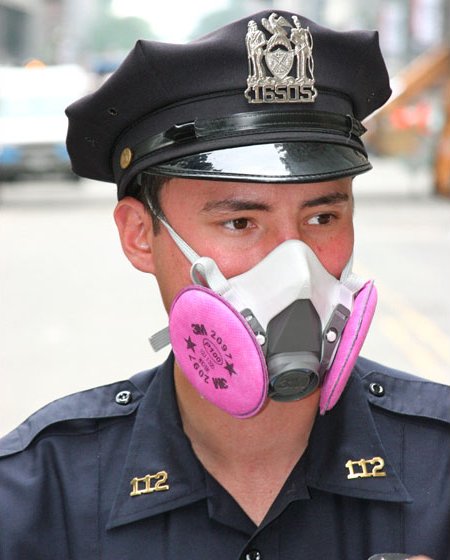
Ebola respirator suit
"We believe there is scientific and epidemiologic evidence that Ebola virus has the potential to be transmitted via infectious aerosol particles both near and at a distance from infected patients, which means that healthcare workers should be wearing respirators, not facemasks. Being at first skeptical that Ebola virus could be an aerosol-transmissible disease, we are now persuaded by a review of experimental and epidemiologic data that this might be an important feature of disease transmission, particularly in healthcare settings. The act of vomiting produces an aerosol and has been implicated in airborne transmission of gastrointestinal viruses. Regarding diarrhea, even when contained by toilets, toilet flushing emits a pathogen-laden aerosol that disperses in the air." These two infectious disease experts believe that Ebola is already – in its current form – transmissible via aerosols. They therefore urge all doctors and nurses working with Ebola patients to wear respirators.
http://www.washingtonsblog.com/2014/10/center-infectious-disease-research-policy-university-minnesota-ebola-may-become-airborne.html
"Most scientific and medical personnel, along with public health organizations, have been unequivocal in their statements that Ebola can be transmitted only by direct contact with virus-laden fluids and that the only modes of transmission we should be concerned with are those termed "droplet" and "contact." These statements are based on two lines of reasoning. The first is that no one located at a distance from an infected individual has contracted the disease, or the converse, every person infected has had (or must have had) "direct" contact with the body fluids of an infected person. This reflects an incorrect and outmoded understanding of infectious aerosols, which has been institutionalized in policies, language, culture, and approaches to infection control. We will address this below. Briefly, however, the important points are that virus-laden bodily fluids may be aerosolized and inhaled while a person is in proximity to an infectious person and that a wide range of particle sizes can be inhaled and deposited throughout the respiratory tract. The second line of reasoning is that respirators or other control measures for infectious aerosols cannot be recommended in developing countries because the resources, time, and/or understanding for such measures are lacking."
http://www.cidrap.umn.edu/news-perspective/2014/09/commentary-health-workers-need-optimal-respiratory-protection-ebola
"Caring for a patient in the early stages of disease (no bleeding, vomiting, diarrhea, coughing, sneezing, etc). In this case, the generation rate is 1. For any level of control (less than 3 to more than 12 ACH), the control banding wheel indicates a respirator protection level of 1 (APF of 10), which corresponds to an air purifying (negative pressure) half-facepiece respirator such as an N95 filtering facepiece respirator. This type of respirator requires fit testing."
Wait, what? If you are caring for a patient who has no symptoms, you should wear a half-facepiece respirator?

Until the idiots at the WHO and CDC get this thing under control, I think anyone with the slightest risk of coming within 100 feet of a possible Ebola patient should be wearing these. That would the entire populations of West Africa, anyone on an international flight and anyone within sight of the Dallas hospital or schools where there is a possible infection.
No comments:
Post a Comment